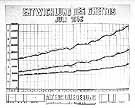
|
|
|

|

|

|

|
|
Click on an image to see a larger, more detailed picture.
|
|
|
|
|
| 1942: The "Final Solution" |

|
pg. 346 |

|
|
|
|
| |
 The Nazis kept meticulous records of the population in the Theresienstadt camp/ghetto. This July 1942 document charts the ghetto's human gender. July marked a significant transition at Theresienstadt: All gentiles were moved out to make room for trainloads of arriving Jews, many of them eminent persons, from Germany and Austria.
The Nazis kept meticulous records of the population in the Theresienstadt camp/ghetto. This July 1942 document charts the ghetto's human gender. July marked a significant transition at Theresienstadt: All gentiles were moved out to make room for trainloads of arriving Jews, many of them eminent persons, from Germany and Austria.
Photo: Czechoslovak News Agency / United States Holocaust Memorial Museum Photo Archive
|
 Yeheskel Atlas was a Polish physician and partisan commander. Atlas's entire family died in the Slonim (Belorussia) Ghetto in November 1941. He remained in the ghetto until July 1942, when he escaped into a partisan company. Atlas led a number of successful attacks against German installations, but he was mortally wounded in a battle at Wielka Wola, Poland.
Yeheskel Atlas was a Polish physician and partisan commander. Atlas's entire family died in the Slonim (Belorussia) Ghetto in November 1941. He remained in the ghetto until July 1942, when he escaped into a partisan company. Atlas led a number of successful attacks against German installations, but he was mortally wounded in a battle at Wielka Wola, Poland.
Photo: Ghetto FightersÕ House / United States Holocaust Memorial Museum Photo Archive
|
 Adam Czerniaków's Diary
Adam Czerniaków's Diary
Adam Czerniaków, a balding engineer in his early 60s, headed the Warsaw Ghetto's Judenrat (Jewish Council) for nearly three years. He wrote almost daily in his diary, which eventually consisted of nine notebooks. The fifth notebook is missing, yet it remains unclear how any part of this important diary survived at all. Rosalia Pietkiewicz, a Warsaw Ghetto survivor, purchased it from an unidentified source in 1959. The original copy has been in Jerusalem at Yad Vashem since 1964. Czerniaków's reports, many of which begin with the morning temperature, reveal him to be a modest man who worked against impossible odds to save Jewish lives. His last entry, dated July 23, 1942, states: "It is 3 o'clock. So far 4000 are ready to go. The orders are that there must be 9000 by 4 o'clock." The numbers refer to the daily quota of Jews that the Nazis required the Judenrat to assemble for "resettlement." All but a relative few of the Warsaw Ghetto's Jews perished in the Holocaust. A majority were deported to Treblinka and gassed. Especially distressed by his inability to save the ghetto's children, Czerniaków committed suicide on July 23, soon after writing his diary's final entry.
Photo: Yad Vashem / United States Holocaust Memorial Museum Photo Archive
|
|

|

|

|

|
 August 4, 1942: The first deportations of Jews from Belgium to Auschwitz begin; the first day's deportees number 998. Throughout Belgium, non-Jewish Belgian households hide 25,000 Jews.
August 4, 1942: The first deportations of Jews from Belgium to Auschwitz begin; the first day's deportees number 998. Throughout Belgium, non-Jewish Belgian households hide 25,000 Jews.
|
 August 4-31, 1942: More than 5600 Jews are deported from Belgium to Auschwitz.
August 4-31, 1942: More than 5600 Jews are deported from Belgium to Auschwitz.
|
 August 5, 1942: SS troops in Radom, Poland, shoot 600 older people and children as well as hundreds of other Jews found in hiding places. Six thousand Jews from the city's small ghetto and 2000 from the large ghetto are deported to the Treblinka death camp.
August 5, 1942: SS troops in Radom, Poland, shoot 600 older people and children as well as hundreds of other Jews found in hiding places. Six thousand Jews from the city's small ghetto and 2000 from the large ghetto are deported to the Treblinka death camp.
|
|
|
|
|
| 1942: The "Final Solution" |

|
pg. 346 |

|
|
The Holocaust Chronicle
© 2009 Publications International, Ltd.
|
|
